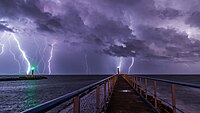
Photo from wikipedia
Transportation sources are a major contributor to air pollution in urban areas, and the role of air quality modeling is vital in the formulation of air pollution control and management… Click to show full abstract
Transportation sources are a major contributor to air pollution in urban areas, and the role of air quality modeling is vital in the formulation of air pollution control and management strategies. Many models have appeared in the literature to estimate near-field ground level concentrations from mobile sources moving on a highway. However, current models do not account explicitly for the effect of wind shear (magnitude) near the ground while computing the ground level concentrations near highways from mobile sources. This study presents an analytical model (SLINE 1.0) based on the solution of the convective–diffusion equation by incorporating the wind shear near the ground for gaseous pollutants. The dispersion coefficients for stable and unstable atmospheric conditions are based on the near-field parameterization. Initial vertical dispersion coefficient due to the wake effect of mobile sources is incorporated based on a literature review. The model inputs include emission factor, wind speed, wind direction, turbulence parameters, and terrain features. The model is evaluated based on the Idaho Falls field study (2008). The performance of the model is evaluated using several statistical parameters. Results indicate that the model performs well against this dataset in predicting concentrations under both the stable and unstable atmospheric conditions. The sensitivity of the model to compute ground-level concentrations for different inputs is presented for three different downwind distances. In general, the model shows Type III sensitivity (i.e., the errors in the input will show a corresponding change in the computed ground level concentrations) for most of the input variables using the ASTM (American Society for Testing and Materials) method. However, some recalibration of the model constants is needed using several field datasets to make sure that the model is acceptable for computing ground-level concentrations in engineering applications.
Journal Title: Atmosphere
Year Published: 2021
Link to full text (if available)
Share on Social Media: Sign Up to like & get
recommendations!